The Intel 6th Gen Skylake Review: Core i7-6700K and i5-6600K Tested
by Ian Cutress on August 5, 2015 8:00 AM ESTWhat You Can Buy: Linux Performance
Built around several freely available benchmarks for Linux, Linux-Bench is a project spearheaded by Patrick at ServeTheHome to streamline about a dozen of these tests in a single neat package run via a set of three commands using an Ubuntu 11.04 LiveCD. These tests include fluid dynamics used by NASA, ray-tracing, OpenSSL, molecular modeling, and a scalable data structure server for web deployments. We run Linux-Bench and have chosen to report a select few of the tests that rely on CPU and DRAM speed.
C-Ray: link
C-Ray is a simple ray-tracing program that focuses almost exclusively on processor performance rather than DRAM access. The test in Linux-Bench renders a heavy complex scene offering a large scalable scenario.
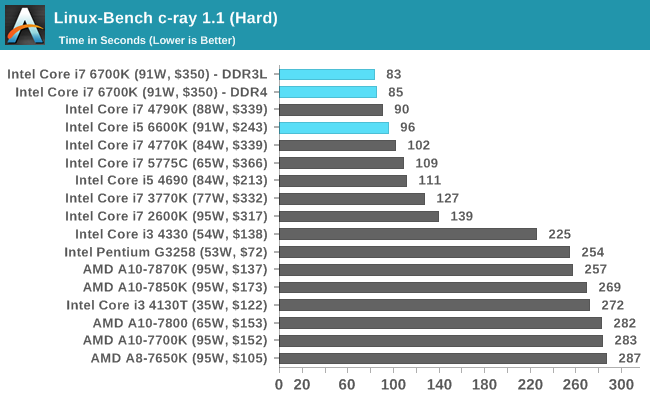
NAMD, Scalable Molecular Dynamics: link
Developed by the Theoretical and Computational Biophysics Group at the University of Illinois at Urbana-Champaign, NAMD is a set of parallel molecular dynamics codes for extreme parallelization up to and beyond 200,000 cores. The reference paper detailing NAMD has over 4000 citations, and our testing runs a small simulation where the calculation steps per unit time is the output vector.
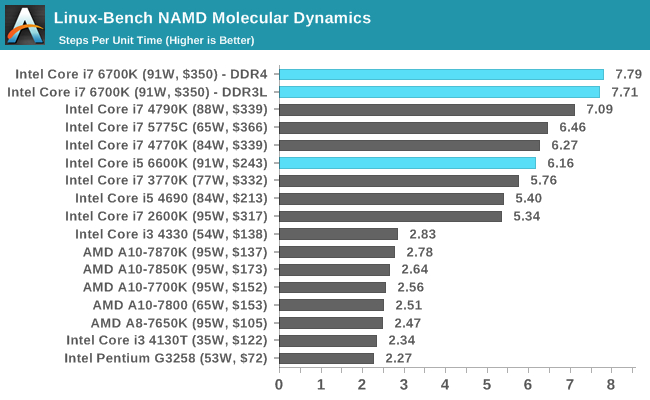
NPB, Fluid Dynamics: link
Aside from LINPACK, there are many other ways to benchmark supercomputers in terms of how effective they are for various types of mathematical processes. The NAS Parallel Benchmarks (NPB) are a set of small programs originally designed for NASA to test their supercomputers in terms of fluid dynamics simulations, useful for airflow reactions and design.
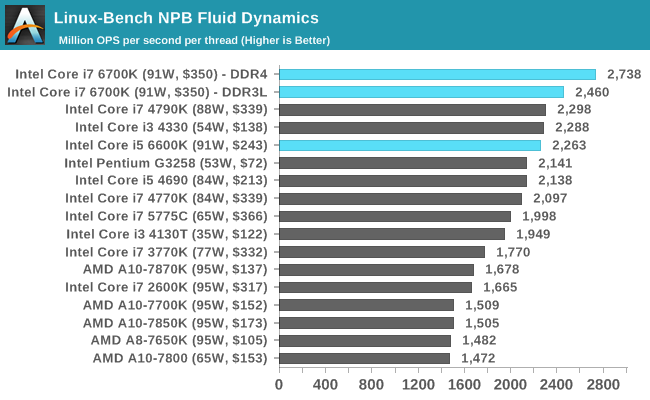
Redis: link
Many of the online applications rely on key-value caches and data structure servers to operate. Redis is an open-source, scalable web technology with a b developer base, but also relies heavily on memory bandwidth as well as CPU performance.
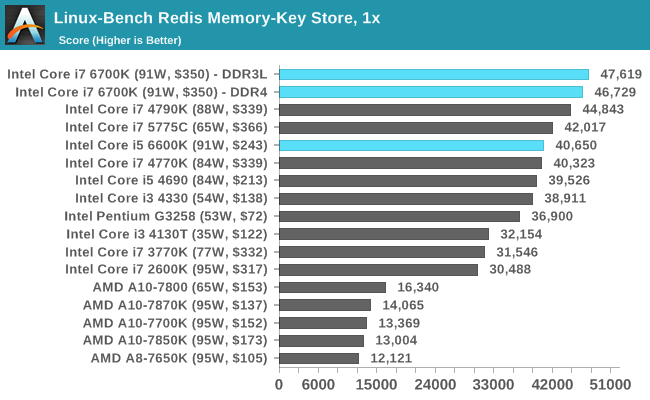
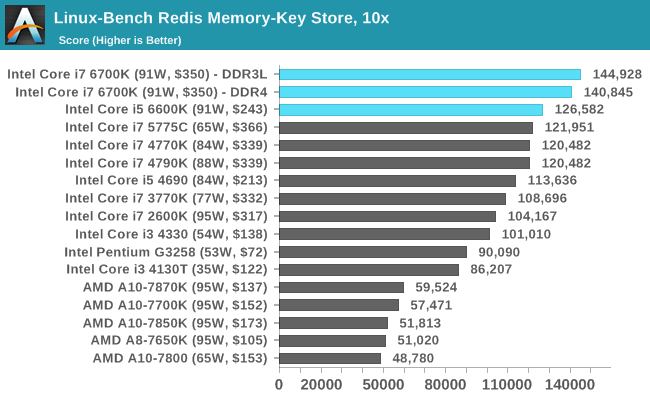
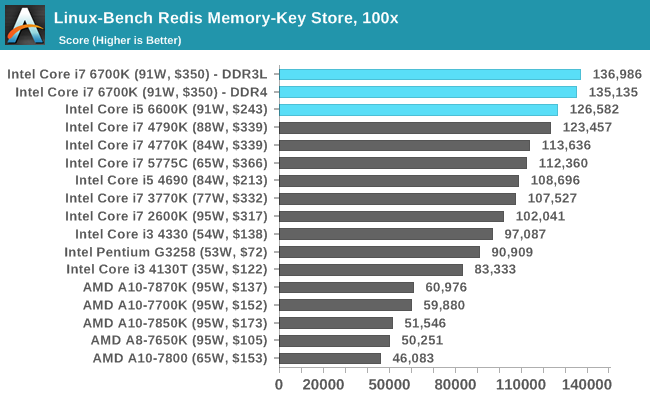










477 Comments
View All Comments
watzupken - Friday, September 4, 2015 - link
To be honest, I feel the recent AMD chips are not so bad. From my opinion it boils down to 2 things,1) They are not able to get software makers to optimize for their chips,
2) Disadvantage in terms of fab, i.e. 28nm vs 20/14nm.
Of course, they also don't have a pocket a deep as Intel to begin with. So any misstep can have a serious setback for them.
i_will_eat_you - Saturday, December 12, 2015 - link
AMD is long dead especially for the desktop market and server market. For their latest highend chips they simply slap bigger and bigger fans/heat sinks on to deal with a higher TDP from a ramped up clock. I'm not even sure if they have a particularly good standing in the "APU" market, low end market, etc. ARM and Intel are doing much better.They only have a slight gain in the GPU market with the push of HBM but even this does not give them a strong lead and they are falling onto Apple like marketing in attempt to boast their sales.
The only reason people might tolerate AMD at the moment is because a lot of tasks will run ok on a CPU that is not the best or not the best value for money.
Until they release a new architecture and a new fabrication process they are becoming completely out of the game. I agree they have no room for error in that.
Synomenon - Monday, August 24, 2015 - link
So it's possible to have the full 16 PCIe 3.0 lanes from the CPU going to the GPU and have 4 PCIe 3.0 lanes from the chipset going to the m.2 drive on a Z170 board?wyssin - Sunday, August 30, 2015 - link
Here's what I'm talking about.In their i7-6700K review article, bit-tech.net compared chips at stock settings AND at a decent overclock. By seeing both of those results, you can see whether an upgrade makes sense for your needs (assuming you are an overclocker).
http://www.bit-tech.net/hardware/2015/08/05/intel-...
oranos - Tuesday, September 15, 2015 - link
Looks like after 5 years, there is still no reason to upgrade a 2500k.sheeple - Thursday, October 15, 2015 - link
I TOTALLY agree with yousheeple - Thursday, October 15, 2015 - link
THIS is funny, I'm using a SUPER OOOOOOLD L5408 Xeon that sips 40 watts and gives the performance of a 4th. gen i3 and runs ALL the latest 2015 games and the L5408 cost me 40 bucks on ebay, HAHAHAHAHAAAAA!!!!sheeple - Thursday, October 15, 2015 - link
My L5408 isn't even overclocked past 2.76 Ghz and runs The Witcher 3 Wild Hunt (game from 2015 on a machine with a cpu and mobo that together cost me 70 bucks used-the cpu was introduced in beginning of 2008) at 30 fps AVERAGE WITH ALL SETTINGS MAXED @ 1080p using a STOCK GTX 950 LOL!!! Whoever buys one of these "Skynet" Cpu's needs to do more research, SERIOUSLY !!!!sheeple - Thursday, October 15, 2015 - link
DON'T BE STUPID SHEEPLE!!! NEW DOES NOT ALWAYS = BETTER!manolaren - Saturday, October 31, 2015 - link
So if Anandtech tests are accurate, between the skylake cpu's, i5 is the way for a gaming pc. Gaming benchmarks are almost identical, but the price is a lot cheaper for the i5. Considering skylake doesn't bring nothing groundbreaking for the genre, then i cant see any other way for gamer's. My only question is if future games will take advantage of more than 4 cores and make i7 cpu's a must.